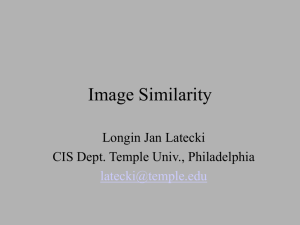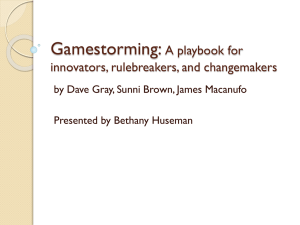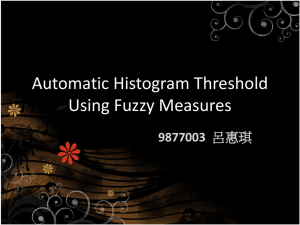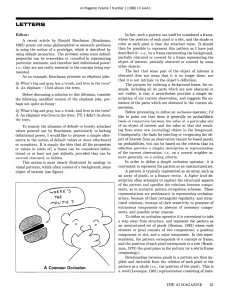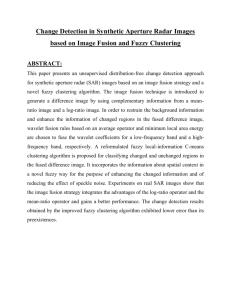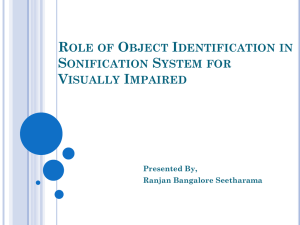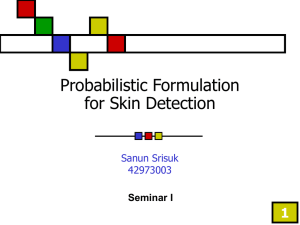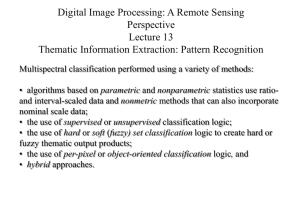On Fuzzy image processing
advertisement
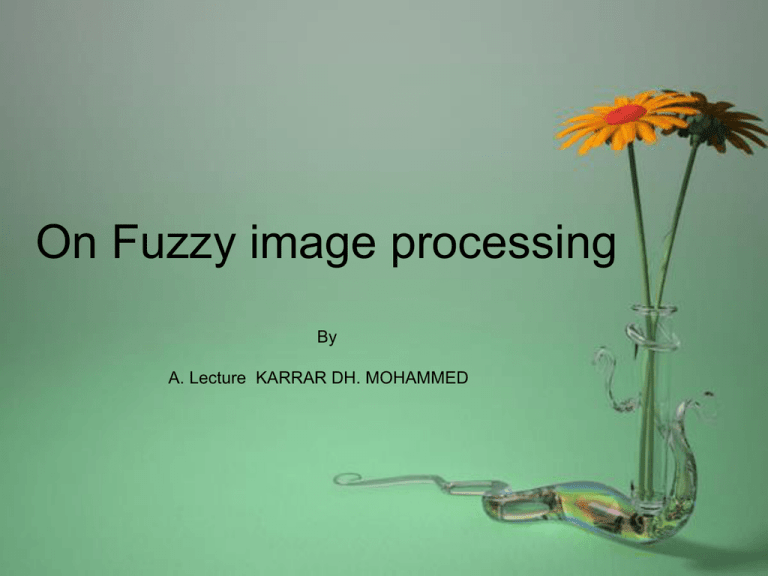
On Fuzzy image processing By A. Lecture KARRAR DH. MOHAMMED History In the 1970s, digital image processing proliferated, when cheaper computers and dedicated hardware became available. Images could then be processed in real time, for some dedicated problems such as television standards conversion. As general-purpose computers became faster, they started to take over the role of dedicated hardware for all but the most specialized and compute-intensive operations. History With the fast computers and signal processors available in the 2000s, digital image processing has become the most common form of image processing, and is generally used because it is not only the most versatile method, but also the cheapest. What is an Image 1. An image f (x, y) is 2-dimensional light intensity function ,where f measures brightness at position (x, y). 2. A digital image is a representation of an image by a 2-D array of discrete samples. 3. The amplitude of each sample is represented by a finite number of bits. 4. Each element of the array is called a pixel. Terminology Images: An image is a two-dimensional signal whose intensity at any point is a function of two spatial variables. Examples are photographs, still video images, radar and sonar signals, chest and dental X-rays. An image sequence such as that seen in a television is a three dimensional signal for which the image intensity at any point is a function of three variables: two spatial variables and time. 1. Digital image processing is a term used to describe the manipulation of image data by a computer. 2. The process of transforming an image to a set of numbers, which a computer can utilized, is called digitization. 3. Digitization is to divide an image up into several picture elements called pixels. A pixel is the smallest resolvable unit of an image which the computer handles. 4. The value of a pixel is referred to as its gray level and can be thought of as the intensity or brightness (or darkness) of the pixel. 5. The number of different gray-levels a pixel can have varies from system to system, and is determined by the hardware that produces or displays the image. Why do we process images Images (and videos) are every where .This includes different imaging modalities such as visual, X-ray, ultrasound, ] etc. Multimedia information will be the wave of the future. Diverse applications in astronomy, biology, geology, geography, medicine, law enforcement, defense, Industrial inspection, require processing of images. Grayscale and Color Images 1. For grayscale image, 256 levels or 8 bits/pixel is sufficient for most applications 2. For color image, each component (R, G, B) needs 256 levels or 8 bits/pixel 3. Storage for typical images (a) 512 × 512, 8 bits grayscale image: 262,144B (b) 1024×768, 2,359,296B 24 bits true color image: Grayscale Image Color Images X R (n,m), X G (n,m), X B (n,m) F(x, y) F(m, n), 0 ≤ m ≤ M − 1,0 ≤ n ≤ N − 1 A digital image can be written as a matrix x(0,1) ..... x(0,N - 1) x(0,0) x(1,0) x (1, 1) ..... x(1, N 1) .... .... .... F .... .... .... .... .... .... .... .... .... x(M - 1, 0) x(M- 1,1) ... x(M - 1, N - 1) Image Operations can be classified as Linear and non-linear Operations: H is a linear operator if if satisfies the superposition principle: H(af +bg) = aH(f)+bH(g) for all images f and g and all constants a and b. 1. Mean filtering: Linear 2. Median filtering: Non-linear Simple Operations On Images Digital Negative: Given an image F, the Digital Negative of F is defined as F Negative (m, n) = 255 − F(m, n) Feature Enhancement by Subtraction A Brief History of Lena (Lenna) Anyone familiar with digital image processing will surely recognize the image of Lena. While going through some old usenet discussions, I got to know that Lena has a history worth all the attention that has been paid to her over the years by countless image processing researchers. Lena Sjblom, (also spelled Lenna by many publications) was the Playboy playmate in November 1972 and rose to fame in the computer world when researchers at the University of Southern California scanned and digitized her image in June 1973. (Lena herself never know of her fame until she was interviewed by a computer magazine in Sweden where she lives with her husband and children). A Brief History of Lena (Lenna) According to the IEEE PCS Newsletter of May/June 2001, they were hurriedly searching for a glossy image which they could scan and use for a conference paper when someone walked in with a copy of Playboy. The engineers tore off the top third of the centerfold and scanned it with a Muirhead wire photo scanner (a distant cry from the flatbed scanners of today) by wrapping it around the drum of the scanner. (Now you know why the image shows only a small part of the entire picture.. discounting of course, the fact that the complete picture would raise quite a few eyebrows. Linear Stretching 1. Enhance the dynamic range by stretching the original gray levels to the range of 0 to 2. Example (a) The original gray levels are [100, 150]. (b) The target gray levels are [0, 255]. (c) The transformation function g(f) = ((f − 100)/50) ∗ 255 for100 ≤ f ≤ 150 Illustration of Linear Stretching Image/video Processing Methods 1. Image Enhancement 2. Image Restoration 3. Compression 4. Image reconstruction 5. Morphological image processing 6. Feature extraction and recognition, computer vision Other Image Operations Image algebra includes mathematical comparisons, altering values of pixels, thresholding, edge detection and noise reduction. 1. Neighborhood averaging is to avoid extreme fluctuations in gray level from pixel to pixel. It is also very effective tool for noise reduction. 2. Image Scaling is a means of reducing or expanding the size of an image using existing image data. 3. Histogram Equalization is an adjustment of gray scale based on gray-level histogram. This is effective in enhancing the contrast of an image. 4. Edge Detection is an operation of measuring and analyzing the features in an image by detecting and enhancing the edges of the features. The most common edge detection method is gradient detection. 5. Image Restoration: Given a noisy image y(m, n) y(m, n) = x(m, n)+v(m, n) where x(m, n) is the original image and v(m, n) is noise. The objective is to recover x(m, n) from y(m, n). Color Restoration Photo Restoration 6. Contrast Enhancement: how to enhance the contrast of an image? 1. Low contrast image values concentrated near narrow range (mostly dark, or mostly bright, or mostly medium values) 2. Contrast enhancement change the image value distribution to cover a wide range 3. Contrast of an image can be revealed by its histogram Histogram The histogram of an image with L possible gray levels, f = 0, 1, · · · , L − 1 is defined as: nl p(l ) n where – nl is the number of pixels with gray level l. – n is the total number of pixels in the image. Examples of Histograms Applications Astronomy: Hubble Space Telescope : This telescope has limitation in resolution due to atmospheric turbulence. Optical problem in a telescope results in blurred, out of focus image. Digital image processing is normally used to recover the desired information from these images. Applications Medical Imaging: Most of advanced medical imaging tools are based on DSP tools. X-Ray computerized Tomography (X-ray CT) is capable of generating a cross-sectional display of the body. This involves X-ray generation, detection, digitization, processing and computer image reconstruction. Similarly, NMRCT (nuclear magnetic resonance). MRI Ultrasound Fingerprint In 1684, an English plant morphologist published the first scientific paper reporting his systematic study on the ridge and pore structure in fingerprints. A fingerprint image may be classified as: (a) Offline: Inked impression of the fingertip on a paper is scanned (b) Live-scan: Optical sensor, capacitive sensors, ultrasound sensors, ... At the local level, there are different local ridge characteristics. The two most prominent ridge characteristics, called minutiae, are: (a) Ridge termination (b) Ridge bifurcation At the very-fine level, intra-ridge details (sweat pores) can be detected. They are very distinctive; however, very high-resolution images are required. Face Recognition Face Recognition Methods (a) Template matching using minimum-distance classifiers metrics (b) Linear discriminants (c) Bayesian approach Watermarking The World Wide Web and the progress in multimedia storage and transmission technology expanded the possibility of illegal copying and reproducing of digital data. Digital watermarking represents a valid solution to the above problem, since it makes possible to identify the source, author, creator, owner, distributor or authorized consumer of digitized images, video recordings or audio recordings. A digital watermark is an identification code, permanently embedded into digital data, carrying information pertaining to copyright protection and data authentication. (a) Copyright protection and authentication Image Compression Techniques 1. JPEG 2000 standard is based on wavelets 2. JPEG (original) is based on the Discrete Cosine An Example of Image Compression What does Fuzzy Image ?Processing mean Fuzzy image processing is not a unique theory. It is a collection of different fuzzy approaches to image processing. Nevertheless, the following definition can be regraded as an attempt to determine the boundaries: Fuzzy image processing is the collection of all approaches that understand, represent and process the images, their segments and features as fuzzy sets. The representation and processing depend on the selected fuzzy technique and on the problem to be solved( From : Tizhoosh, Fuzzy Image Processing ,Springer )1997 ( Fuzzy image processing has three main stages: image fuzzification, modification of membership values, and, if necessary, image defuzzification see figure below .The general structure of fuzzy image processing
